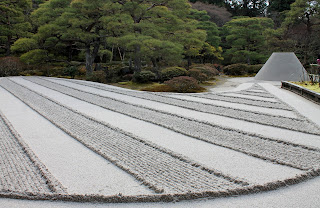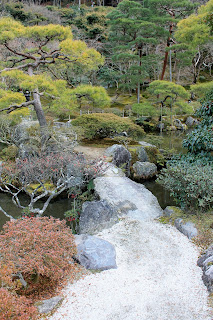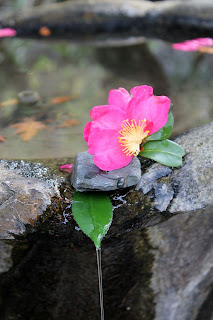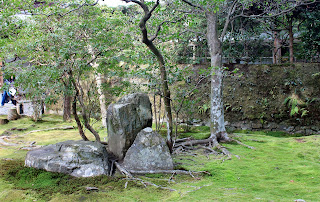Ich verlasse den Tempel und wandere den Philosophenweg entlang, ein kleiner Pfad am alten Kanal, gesäumt von Wohnhäuser, kleinen Geschäften und natürlich etlichen Tempeln und Schreinen. Hier spazierten und spazieren, wer weiß die Philosophen der Kyoto Universität entlang zur Arbeit und zurück. Ich biege nach kurzer Zeit ab und besuche den Honenin Tempel, einen buddhistischen Tempel. Er erscheint unspektakulär, eher etwas zerzaust, aber in einer stillen Lieblichkeit. Das Schönste war ein steinernes Wasserbecken, auf dessen Rand eine Blüte und ein Blatt derart platziert waren, das ein kleines Rinnsal des Wassers über das Blatt läuft und am beeindruckensten war das große moosbewachsene Tor. Dahinter gibt es einen buddhistischen Friedhof, alles sehr idyllisch.
Noch viele andere Schreine und Tempel säumen den Weg am Kanal, aber sie waren alle geschlossen.
Darum ist der nächste Bus meiner und ich fahre nach Gion, bin schließlich Tourist. Ach, und da ist es ja, das Kyoto von Yasunari Kawabata, kleine Häuschen, dicht gedrängt in kleinen Gassen, viele winzige Restaurants, Mädchen und Frauen im Kimono, viele Läden, die Kimonos und Zubehör feilbieten, ein großes Kabuki Theater (http://de.wikipedia.org/wiki/Kabuki) und der Yasaka Schrein.
Es ist schon Nachmittag, also eile ich weiter, nun gut informiert, auf dem Weg zum goldenen Pavillon. Kyoto ist groß und so habe ich doch noch eine Art Stadtrundfahrt, denn die drei offiziellen, die angeboten werden, sind immer gleich ausverkauft. Reiseführer sagen, man soll sich die Besuchszeit wohl überlegen, denn alle Touristen und Schulklassen stürmen hier her. Das finde ich, macht gar nichts, ist ja genug Tempel für alle da. Nach meiner Meinung soll man zum Sonnenuntergang kommen, dann leuchtet er so schön.
Im Gegensatz zu seinem kleinen Bruder, dem silbernen Pavillon, ist der goldenen wirklich golden. Anfangs war er nicht golden. Anfangs war er auch kein Tempel sondern auch hier das Landhaus eines Adligen, nach dessem Tod zum Tempel umgewandelt, vereint er drei Baustile in sich, im Erdgeschoss ein Palast, im zweiten Stockwerk ein Samuraihaus und das Dach eines Zen Tempels. Im Jahr 1950 brannte er ab, wurde fünf Jahre später wieder aufgebaut und nun ist er golden und schön und die Sonne geht unter. Perfekt. das Gebäude steht am Wasser des Spiegelsee, in dem viele Kois leben, auch gibt es sehr viele Wasservögel hier, und egal wo lang man geht, immer hat man einen Blick auf den Pavillon und immer aus einem anderen Blickwinkel.
Danke Kyoto, bis zum nächsten Mal.
My last day in Kyoto, I want to see the golden pavilion, the very landmark of Kyoto, no travel report or photo album without it. Good luck, that I can´t read properly, not to mention that i can´t speak japanese - Kinkakuji and Ginkakiji. That´s why the nice senior at the bus terminal directed me to the east side of Kyoto and after walking through the unavoidable shopping street wich is to be found on every temple or shrine, I stand in front of, ermm, yes, the silver pavilion. But how nice is that, it wasn´t at my list at all, and here i am marvelling. A former privat villa of a Shogun, build in 1482, was turned into a Zen temple after his passing away. The temple is not really siver, more grey, and in front a sea of silver sand and a stone hill, symbolizing the Mt. Fuji. At moon shine the light will be reflect by the pavilion. It´s 11am, and no moon at all, so I stroll around a bit in the garden of the temple, a lot of water, bridges, a hill and a beautiful view onto Kyoto.
Now I´m at the Philosopher Alley, a small way along the old canal, used and maybe still used by the teachers and philosophers of the Kyoto university on their way to work and back. Short time later I take a turn and go and see Honenin temple, a buddhistic one. Not very spectaculair, but a bit tousled, in a very silent loveliness. The most beautiful thing here is a stony water bowl with a flower and a leaf on it´s rim, placed in the way that a small water runlet runs over the leave down. And the most impressing was the big gate with the mossy roof on. Behind there is a buddhistic cemetery, very idyllic all.
A lot of other shrines and temples are found along the way on the cnal, but the are all closed. So the next bus is my one, I´m off for Gion, because I´m a tourist at all. And yes, finally, here it is, the Kyoto of Yasunari Kawabata, small houses in little lanes with tiny restaurants, a lot of girls and women in Kimono, a lot of shops offering kimono and supplies, a Kabuki Theatre (http://en.wikipedia.org/wiki/Kabuki) and the Yasaka Shrine.
It´s already afternoon, so I hurry up, well informed meanwhile, on my way to the golden pavilion. Kyoto is a big city and so I have a bus sightseeing tour, inoffical, because the other three officials are already sold out.
Travel guides say, you should proper think about the time of visit of the golden pavilion, because its always crowded with tourist and school classes. Doesn´t matter, there is enough temple for all. I say, one should choose the evcening, the time at sunset, than the color is so beautiful. Opposide his little brother, the silver pavilion, the golden one is really golden. It wasn´t in the beginning, at first it was a privat villa of a noble, after his death it became a temple, it unites three architectonical styles, ground floor is a palace, the first floor is a hous of a Samurai and the roof is the one of a Zen temple. The building burned down in 1950, was rebuild five years later and now it´s golden all over and it´s beautiful and the sun ist setting and everything is perfect.
It is located a the Mirror Lake, where a lot of kois live in and there are also a lot of water birds. One can surround the lake and from every point one can see the temple, always from a different angle.
Thank you, Kyoto, See you again.






























































































Keine Kommentare:
Kommentar veröffentlichen